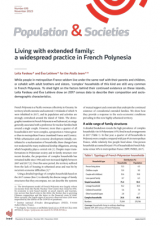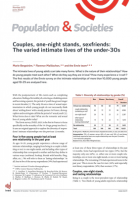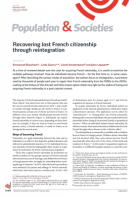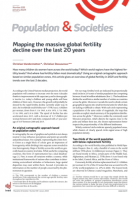
Living with extended family: a widespread practice in French Polynesia
Population and Societies
n° 616, November 2023
https://doi.org/10.3917/popsoc.616.0001
Institut national d’études démographiques (INED),
Institut national d’études démographiques (INED),
Archipels, Territoires et mObilités famiLiaLes (ANR 18-CE22-0001 ATOLLS). https://polynesie.site.ined.fr/fr/ANR-ATOLLs
More than 4 in 10 (41%) French Polynesians live in complex households, the majority sharing a home with several generations of the same family, and a minority coresiding with peers. These households include a large share of young adults and people facing economic insecurity due to a lower-than-average level of education and a higher risk of unemployment. Dwellings occupied by complex households have amenities of similar quality to those of nuclear family households. Coresidence with extended family remains common in this highly urbanized society, providing protection against economic insecurity.
complex household, extended family, census, housing, French Polynesia
Table of contents
- Appendix A References
1.
While people in metropolitan France seldom live under the same roof with their parents and children, or cohabit with adult brothers and sisters, ‘complex’ households of this kind are still very common in French Polynesia. To shed light on the factors behind their continued existence on these islands, Leïla Fardeau and Éva Lelièvre draw on 2017 census data to describe their composition and sociodemographic characteristics.
French Polynesia is a Pacific overseas collectivity in Oceania. Its territory is both extensive and scattered (118 islands of which 74 were inhabited in 2017), and its population and activities are strongly centralized around the island of Tahiti. The demographic transition in French Polynesia is well advanced, at a stage generally associated with a preference for nuclear families built around a single couple. However, more than a quarter of all households in 2017 were complex, a proportion 6.5 times greater than in metropolitan France (mainland France and Corsica). While urbanization and economic development initially contributed to a nuclearization of households, these changes have not weakened the many traditional kinship obligations, among which hospitality plays a central role [1]. Despite major transformations in Polynesian society and in family structure over recent decades, the proportion of complex households has remained stable since 1996 and even increased slightly between 2007 and 2017 [2]. Over this same period, the territory suffered from the lack of housing in urbanized areas and was hit by recurrent economic difficulties [3].1
Using a detailed typology of complex households based on the 2017 census (Box 1) to identify the diverse range of family structures that they encompass, we can describe the systems of mutual support and constraint that underpin the continued existence of coresidential extended families. We show how they provide a response to the socio-economic conditions prevailing in this now highly urbanized territory.
1.1. A wide range of family structures
A detailed breakdown reveals the high prevalence of complex households: 4 in 10 Polynesians (41%) lived in such arrangements in 2017 (Table 1). In that year, a quarter of all households in Polynesia were complex compared with just 4% in metropolitan France, while relatively few people lived alone. One-person households accounted for just 15% of households in French Polynesia versus 36% in metropolitan France (ISPF, INSEE, 2017).
Lineage households and collateral households are the two main categories of complex households. Multigenerational lineage households (representing 16% of all households and 30% of the population) are the most common form of complex coresidence. Many young couples continue to cohabit with the parents of one or the other partner, only moving out when they start a family, or sometimes later. Likewise, older adults may move in with one of their children or be joined by an adult child in their own home. In French Polynesia, life expectancy was 75 years for men and 79 years for women in 20172 (ISPF), but care facilities for dependent older adults are rare.3 A majority (62%) of lineage households comprise three or more generations of the same family line, with a single family nucleus in the intermediate generation (a couple with their children and one grandparent, for example). Half of the remaining households comprise two generations of adults (a parental couple and their children, one of whom lives with a partner in the household), and the other half are multigenerational households including several family lines. The age distribution of these households shows that they comprise a majority of young adults (ages 20–30), their (very) young children, and, to a lesser extent, their elders (Figure 1).
Collateral households represent around 5.5% of households and 7.4% of individuals. They are formed by members of a same family, but without their elders. This living arrangement is often preferred by young adults who have left the parental home but cannot afford to live alone or in a nuclear family. This phase of coresidence during adolescence or early adulthood has been documented by anthropologists [5]. Half of all collateral households comprise a family nucleus along with other single family members (coresident sisters of which only one with a partner, for example). A quarter count unpartnered and childless members (brothers and cousins, for example). The remainder corresponds to households comprising several families with collateral ties (brothers and sisters, of which at least two have a partner). The age pyramid of these household members shows that most are young adults (ages 20–35).
Traditionally, in French Polynesia, extended family coresidence contributed to sharing and maintaining farmland and land rights. But the contemporary Polynesian economy no longer justifies this living arrangement. The population is now highly concentrated in the urban agglomeration of Papeete on the island of Tahiti (49.6% in 2017), where living conditions are very different from those on which the traditional rural model is based. The sociodemographic profile of these extended family households bears witness to these changes.
1.2. Members may be economically insecure…
In a context of limited access to economic resources and housing, sharing a home with extended family still provides a means to pool resources and income. Unemployment rates are high in French Polynesia: 21% in 2017 compared with 6.8% in metropolitan France in the same year. Moreover, in the absence of unemployment benefits or job-seekers’ allowances and given the few job opportunities on the most remote islands, people available to work may report being inactive [6].
The census sheds light on the sociodemographic characteristics of complex household members, providing data on their employment status (employed/unemployed) and educational level (tertiary qualification/primary qualification/no qualification). Figures 2 and 3 show, respectively, the individual probabilities of living in a lineage household or a collateral household by comparable age structure (based on logistic regressions). The bar labelled Overall gives the total share of people aged 15 and above living in a lineage household or a collateral household.
People with tertiary qualifications less frequently live in complex households. They are half as likely to live in a lineage or collateral household as all individuals at the same age. Conversely, people with few or no qualifications are 25% more likely to live in a lineage or collateral household. Clearly, educational level is an important determinant of coresidence with extended family members. Finding a job is more difficult for the least qualified individuals: 40% of those with only a primary or lower secondary qualification were jobless in 2022. By contrast, the unemployment rate is just 11% for people with an upper secondary qualification and 4% for those with a tertiary qualification [6].
This is confirmed by the proportions of unemployed and employed people living in complex households. Unemployed people live much more often than employed people in lineage households (39% vs. 26%) and in collateral households (9% vs. 7%). Employed people are less likely to live in these types of households than the population as a whole at the same age.
Economic insecurity thus appears to increase the likelihood of coresidence with extended family members. Sharing a home makes it easier to pool economic resources and share household tasks between family members.
1.3. … but less exposed to poor housing conditions
The comfort of a dwelling depends upon the amenities it provides. The absence of a kitchen, bathroom, running water, sewerage, or refuse collection4 has a significant impact on the occupants’ well-being. These components of substandard housing may affect the household’s daily welfare and hygiene, exposing them to the risk of ill health. People living alone are most exposed to substandard housing conditions (Figure 4). Almost 5%, a percentage well above that of the other categories, live in housing with at least three of the components of substandard housing mentioned above.
It is lineage households, on the other hand, that least commonly live in substandard dwellings, with just 1.2% counting at least three components of substandard housing. For collateral households, the proportion is 2.3%. Collateral households thus inhabit dwellings of slightly lower quality than those of lineage households, but the proportion is well below that of households overall (3.4%) and similar to that of nuclear families.
A higher proportion of people living alone also occupy makeshift dwellings (caravans, mobile homes, shacks, etc.): 2.6% compared with between 1.2% (lineage households) and 1.8% (couples with children) for the other population categories. For collateral households, the proportion is 1.7%, similar to that of childless couples (1.6%) and below that of households overall (1.8%).
Complex households rarely live in makeshift or severely substandard dwellings. Coresidence with extended family may thus avoid situations of extreme housing insecurity. Whether inter- or intragenerational, cohabitating families enjoy better housing conditions. Among complex households, collateral households slightly more often occupy substandard housing but in the same proportion as nuclear families.
These forms of coresidence alleviate the difficulties associated with economic insecurity. The less favourable situation of people living alone suggests that coresidence with extended family also protects against the risks of housing insecurity. That said, coresidence of this type presents other risks, such as overcrowding, not covered here. This may occur when several family nuclei live together in an unsuitable home, in urban areas especially, where dwellings are smaller and where 50% of the French Polynesian population now live [2]; almost 60% of overcrowded dwellings are occupied by multifamily households [7].
1.3.1. Box 1. Data and method
This study draws on data from the 2017 census of French Polynesia. This exhaustive 5-yearly census is conducted by the National Institute of Statistics and Economic Studies (INSEE) with the support of the Statistical Institute of French Polynesia (ISPF).
The different forms of coresidence are identified via the household, a statistical unit defined by the French and Polynesian statistical offices as ‘the set of occupants of a primary residence, whether they are relatives or not’ (ISPF).
A simple household comprises a person living alone or a family nucleus that includes several subcategories (couple with or without children and lone-parent family). All other types of households are categorized as complex households, but generally without further detail.
Appendix A References
-
[1] Bastide L., 2020, Les violences familiales en Polynésie française. Entrer, vivre et sortir de la violence (Injep Rapports d’étude No. 2020/15).
-
[2] Sierra-Paycha C., Trabut L., Lelièvre E., Rault W., 2022, Les ménages complexes en Polynésie française. Résistance à la nucléarisation ou adaptation à la ‘modernité’? Espace populations sociétés, 1. https://doi.org/10.4000/eps.12347
-
[3] Merceron F., Morschel J., 2013, Tahiti et ses périphéries insulaires : formation et crise d’un espace centralisé, Hermès, 65(1), 56–63. https://doi.org/10.4267/2042/51494
-
[4] Siu D., Pasquier J., 2019, Les matahiapo, un enjeu de la croissance économique, Points Études et Bilans de la Polynésie française, 1226.
-
[5] Grepin L.-H., 2001, L’adolescence masculine aux tuamotus de l’est aujourd’hui : le taure’are’a : contradictions et transformations d’une catégorie sociale traditionnelle [PhD thesis], EHESS.
-
[6] Bodet C., 2022, L’emploi progresse en 2022, le nombre d’inactifs ne souhaitant pas travailler également, Points Études et Bilans de la Polynésie française, 1359.
-
[7] Pasquier J., 2020, Le quotidien des Polynésiens en confinement, Points Études et Bilans de la Polynésie française, 1199.
The development model of French Polynesia was largely reliant on income from the Pacific Nuclear Test Centre that closed in 1996. Its economy is now based mainly on pearl exports and tourism, two sectors that faced crisis in the 2010s, the former due to growing Chinese competition and the latter to the financial crisis of 2008. More recently, the fragile signs of recovery observed since 2018 were imperilled by the fallout of the COVID-19 pandemic.
By comparison, life expectancy was 85 years for women and 80 years for men in metropolitan France in the same year (INSEE). Also in 2017, life expectancy in New Zealand (the region’s leading developed country) was 83 years for women and 80 years for men (Stats NZ).
According to the Direction des Solidarités, de la Famille et de l’Égalité of French Polynesia, the islands counted one centre for older adults and around 20 small private facilities in 2020 [4].
These are the criteria defined by INSEE to identify substandard housing.
More than 4 in 10 (41%) French Polynesians live in complex households, the majority sharing a home with several generations of the same family, and a minority coresiding with peers. These households include a large share of young adults and people facing economic insecurity due to a lower-than-average level of education and a higher risk of unemployment. Dwellings occupied by complex households have amenities of similar quality to those of nuclear family households. Coresidence with extended family remains common in this highly urbanized society, providing protection against economic insecurity.
Cite the article
Leïla Fardeau, Éva Lelièvre for the Atolls team, Living with extended family: a widespread practice in French Polynesia , 2023, Population and Societies, no. 616
 This document may be reproduced free of charge on paper or online using our Creative Commons licence.
This document may be reproduced free of charge on paper or online using our Creative Commons licence.









